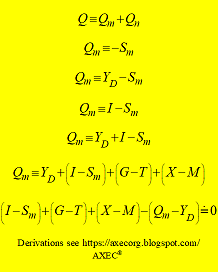Blog-Reference and Blog-Reference
Brian Romanchuk defines the starting point of Post-Keynesian analysis as follows: “The defining characteristic of workers is that they are paid a wage, which is normally fixed nominally …. If we assume that all output is the result of wage labour, we can arrive at the identity (due to Weintraub): P=κW/R (i), where: κ is the average markup; W is the nominal wage rate; R is the output per worker.” (symbols altered from p, w, y to P, W, R)
He then argues: “The argument in Post-Keynesian Economics is that markups cannot rise forever, as that would imply an ever-rising profit share of national income. … Instead, we need to look at the first two terms: how much greater wage growth is than output per worker…. The analysis then leads to: why will wage gains outstrip productivity? The post-Keynesian answer is that this will happen if workers’ bargaining position increases relative to that of business owners.” “By most accounts, the bargaining position of labour has been crippled as a result of structural changes imposed since the early 1980s. From this standpoint, the deceleration of inflation is no accident.”
The inexcusable fault of Post Keynesianism is that the economy is ill-defined. #2 The scientific incompetence of Brian Romanchuk consists of failing to realize that the lethal blunder of Post Keynesianism lies in the inconsistency of foundational macroeconomic relationships.
To make matters short: here is the correct core of macroeconomic premises: #3
(A0) The objectively given and most elementary systemic configuration of the production-consumption economy consists of the household and the business sector, which in turn consists initially of one giant fully integrated firm.
(A1) Yw=WL wage income Yw is equal to wage rate W times working hours. L,
(A2) O=RL output O is equal to productivity R times working hours L,
(A3) C=PX consumption expenditure C is equal to price P times quantity bought/sold X.
The three axioms are supplemented by four definitions: expenditure ratio ρE≡C/Yw, sales ratio ρX≡X/O, monetary profit/loss Qm≡C−Yw, and monetary saving/dissaving Sm≡Yw−C. This yields the most elementary version of the macroeconomic accounting identity, i.e., Qm≡−Sm.
Given the conditions of market-clearing ρX=1 and budget-balancing ρE=1, the market-clearing price is derived for a start as P=W/R (ii). So, the macroeconomic price P is determined by the wage rate W, which has to be fixed as a numéraire, and the productivity R.
When the price is not the dependent variable but set by the markup formula (i), things change.
From (A3) C=PX and (i), and the definitions of the sales ratio and expenditure ratio follow for the general case: ρX=ρE/κ. (iii)
This formula says: the business sector can set the markup κ as high as it wants, but, given the household sector’s expenditure ratio ρE=1, it cannot sell the whole output, i.e., X<O, i.e., ρX<1. This means that the inventory increases. This means also that the business sector cannot increase monetary profit because with P up and X down C does not change, and monetary profit Qm≡C−Yw remains unchanged. So, the business sector as a whole cannot determine its profit by markup pricing. The necessary condition for profit coming into existence is ρE>1.
Eq. (iii) says in detail
• If the markup κ is greater than the expenditure ratio ρE, the market is not cleared, i.e. the stock of unsold output increases, which leads eventually to production cuts and decreasing employment.
• If the markup κ is less than the expenditure ratio ρE, the inventory decreases and production is eventually ramped up.
Macroeconomic profit Qm is alone determined by the expenditure ratio Qm≡(ρE−1)Yw and NOT by the markup κ. This means that the workers’ bargaining position is of NO importance for the profit ratio Qm/Yw and this means, in turn, that Post-Keynesian price, profit, and employment theory has never been anything else than proto-scientific garbage.
Monetary profit and the relation of profit to wage income depend in the closed economy mainly on the growth of public and private debt. This follows from the axiomatically correct macroeconomic Profit Law Qm≡−Sm+Yd+I+(G−T)+(X−M).#4
Egmont Kakarot-Handtke
#1 Preceding Economics as tireless production of proto-scientific garbage: inflation theory as an example
#2 Why Post Keynesianism Is Not Yet a Science
#3 True macrofoundations: the reset of economics
#4 Graphic, AXEC143d Profit Law
Related 'Are economics professors really that incompetent? Yes!' and 'The Levy/Kalecki Profit Equation is false' and 'Keynes, Lerner, MMT, Trump, Biden and exploding profit'.
***
AXEC143d
